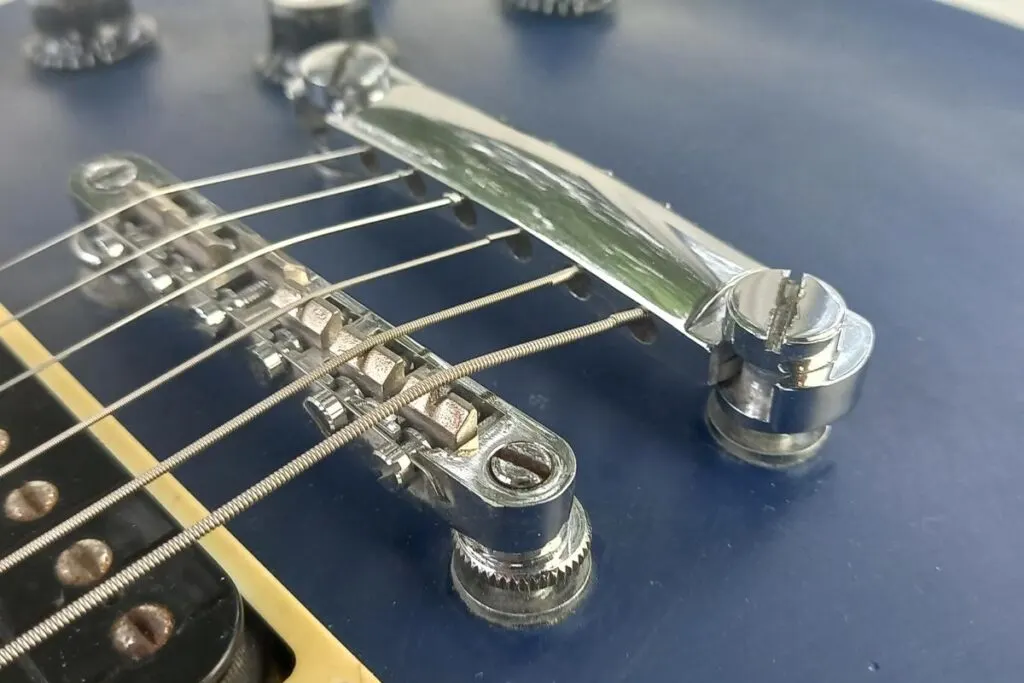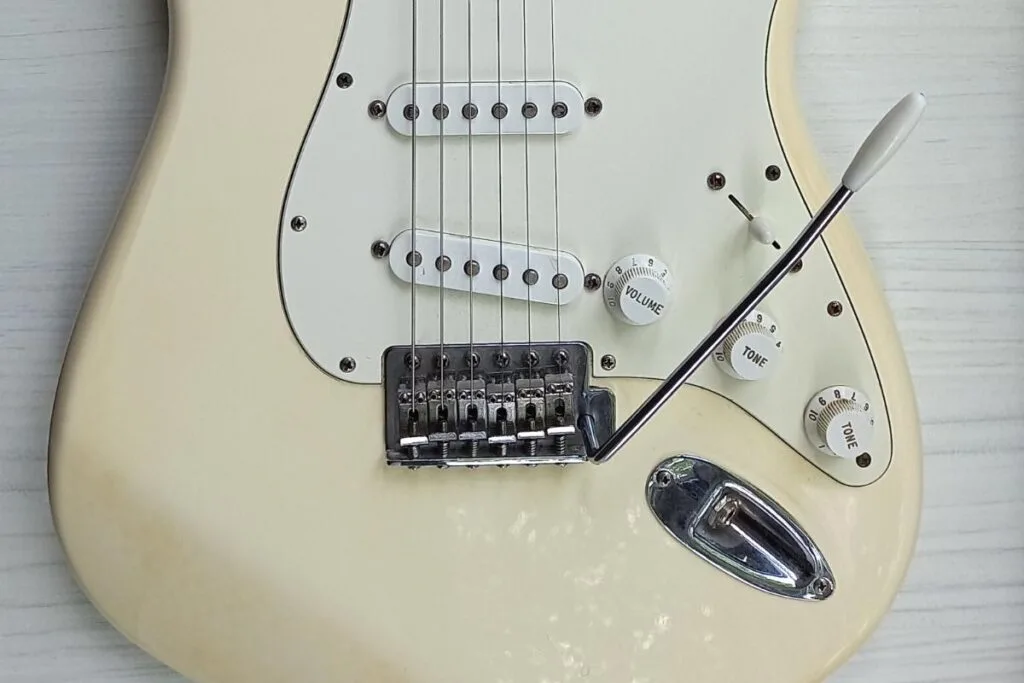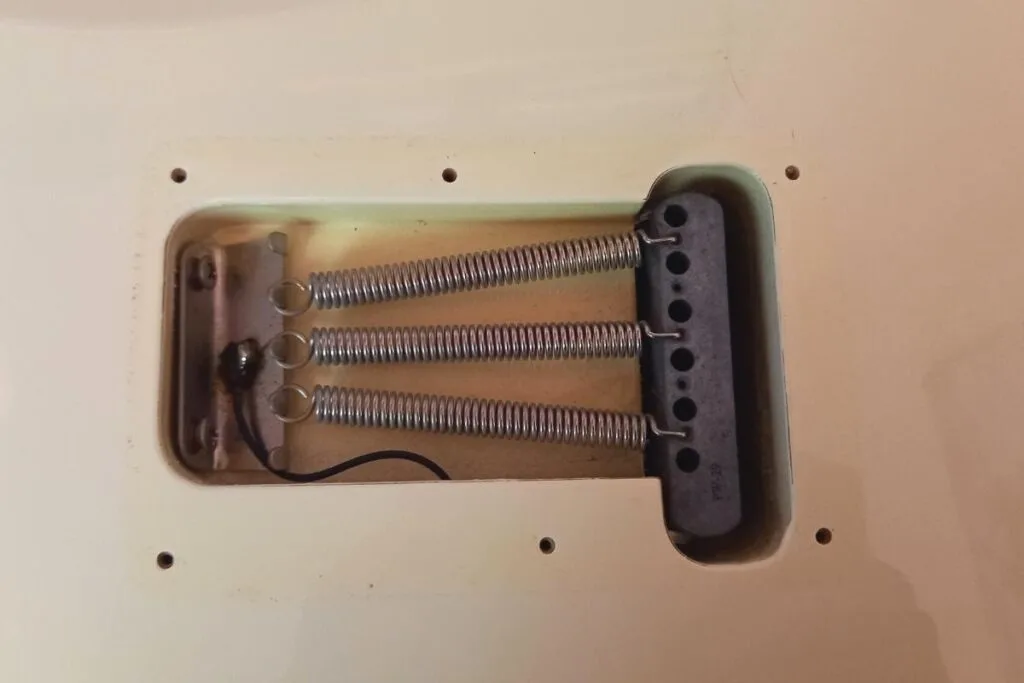The bridge on an electric guitar is an essential part of its overall sound, and there are many different types available. Some guitar’s, like the Les Paul, are known as “hardtail” guitars – but what does that mean?
A hardtail guitar is an electric guitar with a fixed bridge. This means that the bridge doesn’t move as you play, making it more stable. Hardtail guitars often don’t go out of tune as quickly as guitars with tremolo (or moving) bridges. They are well-suited to musical styles like country and blues.
But, that’s not all…
Did you know that hardtail guitars have different tonal properties than tremolo bridges? Or that you can turn a tremolo bridge into a hardtail guitar?
Let’s take a look at the hardtail guitar in more detail and compare it with the more common tremolo bridge.
You can use these links to jump to different sections:
What is a hardtail guitar?
The very first electric guitars took a lot of design inspiration from acoustic and lap steel guitars. They still had many of the same components as these guitars, including a bridge that was fixed in place. This is referred to as a “hardtail” or “fixed” bridge. Any electric guitar with one of these fixed bridges is called a hardtail guitar.

How the hardtail bridge works
A hardtail bridge is a bridge fixed to the guitar’s body with screws. There are no moving parts, except for the saddles. The saddles are used for setting intonation and shouldn’t be adjusted too often under normal circumstances.
The guitar’s strings are fed through holes in the bridge, located at the front of the guitar’s body. The strings are then passed over the saddles and pickups, and eventually through the corresponding tuning pins on the headstock.
The fact that the bridge is fixed in place means that no amount of playing will change the position of the bridge. This makes it a great choice for guitarists looking for tuning stability!
Advantages of hardtail bridges
The hardtail bridge offers quite a few advantages when compared to floating tremolo bridges.
- Fewer parts means less maintenance. The more parts a bridge has, the more likely it is that something can go wrong over time. Especially with moving parts, like on a tremolo bridge. Hardtail bridges have less parts and are stationary, making them more reliable, and easier to maintain, than tremolo bridges.
- Better tuning stability. One factor that can cause guitar strings to lose their tuning is the bridge. A bridge that moves, like a tremolo bridge, can cause strings to slip and lose their tuning. A hardtail bridge keeps the strings firmly in place.
- Better sustain. Most fans of hardtail guitars claim that hardtail bridges improve sustain and resonance. Though, the degree of this is greatly debated online. Personally, I’ve noticed that my hardtail Les Paul has great sustain than my tremolo bridge Stratocaster.
- Unison bends (or partial bends). A hardtail bridge allows you to bend one string without affecting any of the other strings. These string bends are common in styles like country, and are much harder to perform correctly on a tremolo bridge since the bridge’s movement will make the other strings go out of tune.
- It’s easier to change strings. Many tremolo bridges require you to feed the guitar strings through holes from the back of the body. With a hardtail bridge, you simply feed the strings through the bridge, working only on the front of the guitar. In my experience, this makes it a little bit easier to change your strings.
- Affordability. Hardtail bridges are some of the most affordable bridges. Due to the lower complexity of the bridge, they tend to be much cheaper than comparable tremolo bridges.
Disadvantages of hardtail bridges
However, there’s one significant disadvantage to a hardtail bridge. Hardtail bridges don’t allow for the use of a whammy bar (known properly as a “trem arm”), since these rely on the movement of the bridge to do their magic.
This means that you can’t have have vibrato on open strings or chords, though you can still use techniques like hand-vibrato.
You can decide for yourself whether that will be a deal breaker for you or not. Personally, I don’t use vibrato all too often. I’ve actually “decked” the vibrato system on my Stratocaster, meaning that it no longer moves.
Hardtail guitars vs tremolo guitars
Now that we’ve seen the advantages of a hardtail bridge, let’s compare it with the more modern (and incorrectly named) “tremolo” bridge.
Most modern electric guitars come with a floating tremolo bridge, made famous by Leo Fender on the legendary Stratocaster. In fact, it’s hard to walk into a music instrument store and find a guitar without one.

That doesn’t necessarily mean that a floating tremolo better than a hardtail; they’re just different. Most guitarists, including myself, have a few of each to play based on their requirements at the time.
Unlike a hardtail bridge, floating tremolo bridges can move up and down. They are generally mounted with springs located in the back of the guitar’s body, making them flexible and moveable. The guitar strings are fed through holes in the backplate of the body that pass through the bridge’s inner mechanism, attached to the body by springs.
The strings then pass through the bridge, over the saddles, and across the pickups and fretboard. The process of restringing a tremolo bridge is a bit trickier than a hardtail. That being said, it only takes about 5 minutes longer based on my experience.

The primary advantage that a tremolo bridge has over a hardtail guitar is that it changes how you play. String bends and vibrato notes become much easier. By attaching a whammy bar, you can move the bridge to create other sound effects like vibrato.
However, the movable tremolo bridge does have its downsides. The most obvious is that bending a string on a tremolo guitar also bends all the strings with it. This is because the string bend pulls on the bridge, moving it.
Also, using the whammy bar can cause your strings to slip, which will affect their tuning.
What is a hardtail Stratocaster?
A hardtail Stratocaster is a Fender Stratocaster that has a fixed bridge instead of a tremolo bridge.
The Fender Stratocaster was initially released with a floating tremolo bridge. It’s still the most prevalent design – even among copies. However, some limited edition Stratocasters models are made with a fixed bridge. These are often more expensive than their floating tremolo counterparts.
A hardtail Stratocaster benefits from the improved tuning stability and sustain of a fixed bridge.
Playing on a hardtail Strat when you’re used to a floating bridge Strat feels different, and there is a definite and detectable difference in the sound.
I’m a big fan of hardtail Stratocasters, as I prefer a fixed bridge. If you’re like me and want to get the benefits of a hardtail Stratocaster, without replacing your existing bridge, then you can “deck” or “block” you bridge.
Hardtail guitars vs blocked tremolo guitars
Those who want some advantages of both tremolo and hardtail guitars can opt for a blocked tremolo bridge. Now, tremolo blocking doesn’t give you the full benefits of a hardtail, but it can be an effective “quick fix” solution.
A blocked tremolo when the cavity behind the tremolo system is filled with a block of wood. This wood stops the tremolo system from moving. If done properly, blocking a tremolo effectively turns a tremolo bridge into a fixed bridge.
Some of the advantages of blocked tremolo guitars are:
- Improved sustain. You get higher sustain. Mostly not as much as with a hardtail, but there is a definite improvement in the sustain of your notes, and potentially even some tone changes too.
- Improved tuning stability. It helps your guitar to stay in tune, similar to what a hardtail bridge does. Also, your guitar stays tuned even if a string breaks (since the other strings don’t move.
Blocking a tremolo is a fairly straightforward modification that can be done at home! If you’re not comfortable with blocking the tremolo, you can instead “deck” it.
Decking a tremolo is when the tremolo strings are so tight that that the bridge doesn’t move. I’ve decked the bridge on my Stratocaster.
This doesn’t do much to improve the sustain, but it does improve the guitar’s tuning stability.
Hardtail vs blocking: Which is better?
With many of the benefits of a hardtail bridge, a blocked tremolo is a great alternative, so much so that people even refer to the modification process as “hardtailing” your guitar.
Here’s my thoughts on which is best:
- Hardtail guitars are perfect for beginners due to their simplicity and for those who play styles like country or blues.
- Floating tremolo guitars are a popular next step for guitarists, especially those who want to play more rock solos.
- The blocked tremolo is popular with guitarists who want an even heavier sound or who want to occasionally drop their tuning.
- A decked bridge is a great alternative to blocking a bridge, if you’re not comfortable with guitar DIY.
Conclusion
As with anything guitar related, there’s no clear-cut “best guitar bridge” option.
The hardtail is a proven system, demonstrated even more by guitarists who modify their floating bridges to be more like hardtails. My recommendation is to go to your local guitar store and try playing around with both and seeing which you prefer. Or, if your budget allows for it, get one of each. It’s always good to have one of each on hand to be able to diversify your guitar-playing skills.


Conor is a music producer, multi-instrumentalist, and all-round enthusiast from the UK with over 15 years of experience. He’s the founder and sole-content creator for the roundtable audio blog and YouTube channel.
